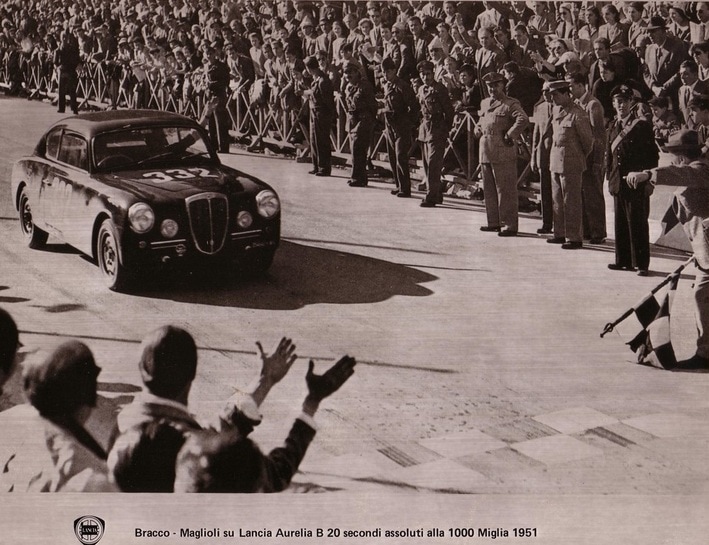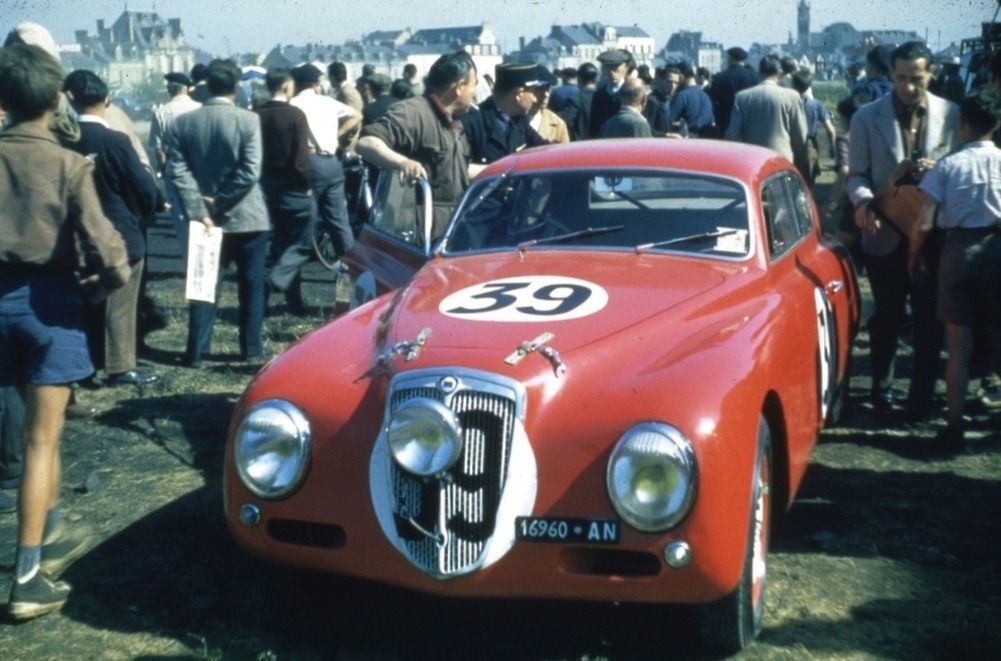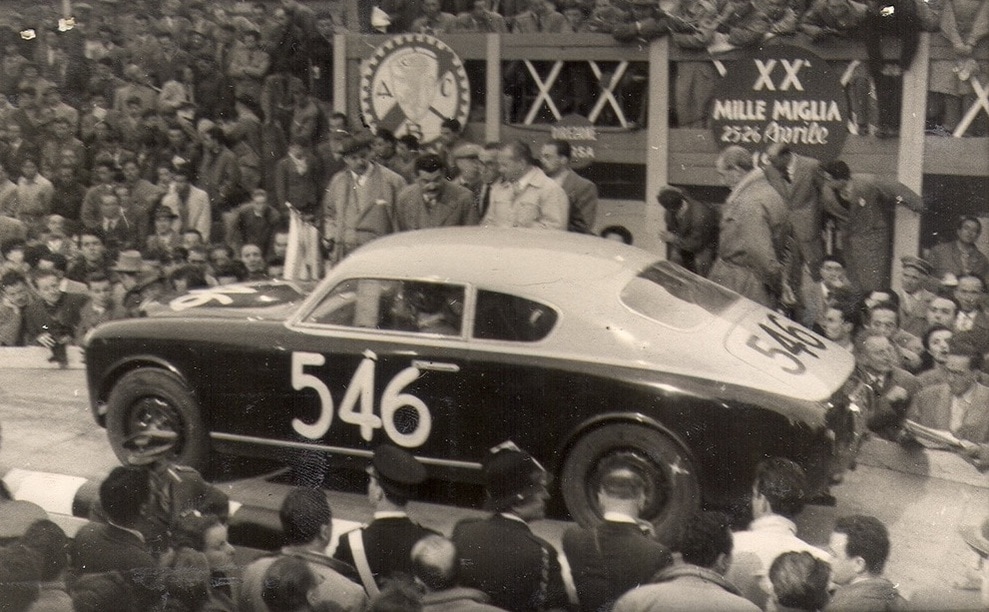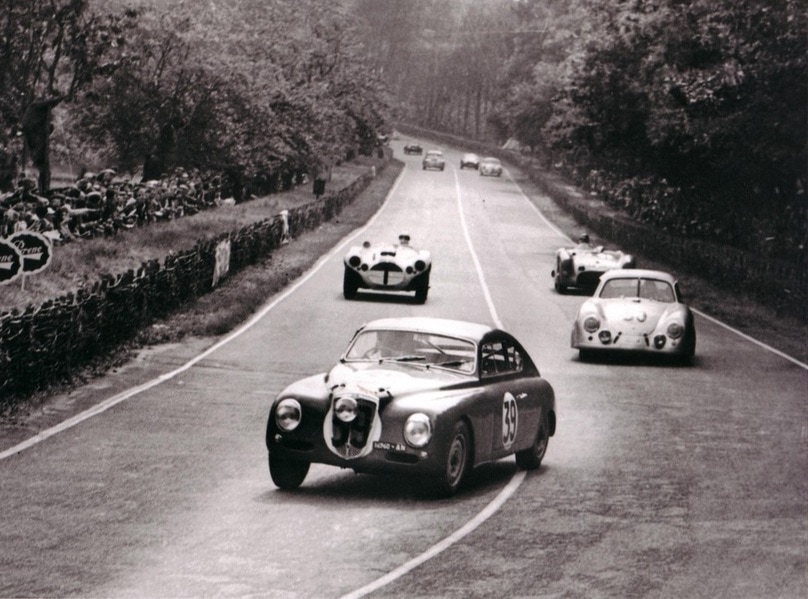Lancia Aurelia
in Competition
Going to the races
Initial factory involvement began in April 1951 at the Giro di Sicilia, quickly followed later that month when Lancia entered the Mille Miglia with several of the newly introduced B20s. The results were better than hoped for — a surprising second place for Lancia’s basically stock B20. The reputation of the Aurelia as the “giant killer” had begun, and even the highly reputable British racing magazine, Autocourse, called 1951 "the year of the Aurelia".
Modified cars
Performance enhancements for Aurelias were initially done with minimal factory involvement. Improvements to the motor were done by Enrico Nardi, a specialist tuner with a small shop near the factory. For the early Aurelias, Nardi’s revisions focused on installing two carburetors instead of the single that came with the car. His Aurelia carburetor setup was available for sale just a few months after the car’s introduction, mounting two double-barreled Solex carburetors.
Initial factory involvement began in April 1951 at the Giro di Sicilia, quickly followed later that month when Lancia entered the Mille Miglia with several of the newly introduced B20s. The results were better than hoped for — a surprising second place for Lancia’s basically stock B20. The reputation of the Aurelia as the “giant killer” had begun, and even the highly reputable British racing magazine, Autocourse, called 1951 "the year of the Aurelia".
Modified cars
Performance enhancements for Aurelias were initially done with minimal factory involvement. Improvements to the motor were done by Enrico Nardi, a specialist tuner with a small shop near the factory. For the early Aurelias, Nardi’s revisions focused on installing two carburetors instead of the single that came with the car. His Aurelia carburetor setup was available for sale just a few months after the car’s introduction, mounting two double-barreled Solex carburetors.
The Corsas
By early 1952, Lancia had committed to a full in-house racing effort and had established a factory team. To make the cars more competitive, Lancia constructed seven lightweight Corsas, in-house all aluminum-bodied race cars built on the B20 chassis. The Corsas had streamlined aluminum bodies with lowered roof and fender lines and stripped interiors for less weight. While all of the original Corsas were destroyed, several replicas were made in the 1980s-90s by Basso.
By early 1952, Lancia had committed to a full in-house racing effort and had established a factory team. To make the cars more competitive, Lancia constructed seven lightweight Corsas, in-house all aluminum-bodied race cars built on the B20 chassis. The Corsas had streamlined aluminum bodies with lowered roof and fender lines and stripped interiors for less weight. While all of the original Corsas were destroyed, several replicas were made in the 1980s-90s by Basso.
Competition B20 based on the third series
In early 1953 the factory prepared a second group of race cars, based on the third series B20. Steel production bodies were equipped with improvements, such as light weight sliding Perspex windows, flush door handles, special bucket seats, air scoop for ventilation, a revised fuel tank, better front brake venting, and two spare wheels. Long cables ran from the driver to the rear shocks for modifying shock settings while driving. With aluminum trunk and hood, weight was down 75 pounds from the production cars, but more notably, the cars featured the new GT 2500 motor, now with three twin-barrel Solexes, arranged in a “skewed” layout to fit on a factory manifold. Registered in March 1953, their first outing was at the Giro di Sicilia in April.
In early 1953 the factory prepared a second group of race cars, based on the third series B20. Steel production bodies were equipped with improvements, such as light weight sliding Perspex windows, flush door handles, special bucket seats, air scoop for ventilation, a revised fuel tank, better front brake venting, and two spare wheels. Long cables ran from the driver to the rear shocks for modifying shock settings while driving. With aluminum trunk and hood, weight was down 75 pounds from the production cars, but more notably, the cars featured the new GT 2500 motor, now with three twin-barrel Solexes, arranged in a “skewed” layout to fit on a factory manifold. Registered in March 1953, their first outing was at the Giro di Sicilia in April.
By then, focus at Lancia shifted to more special purpose D series sports racing cars, first the D20, and then to the D23 and D24. Factory support for the B20s lessened and the Aurelia's future successes were from privateers for the rest of the remaining 1950s.
site design and content copyright G. Goldberg, images as noted Proudly powered by Weebly



